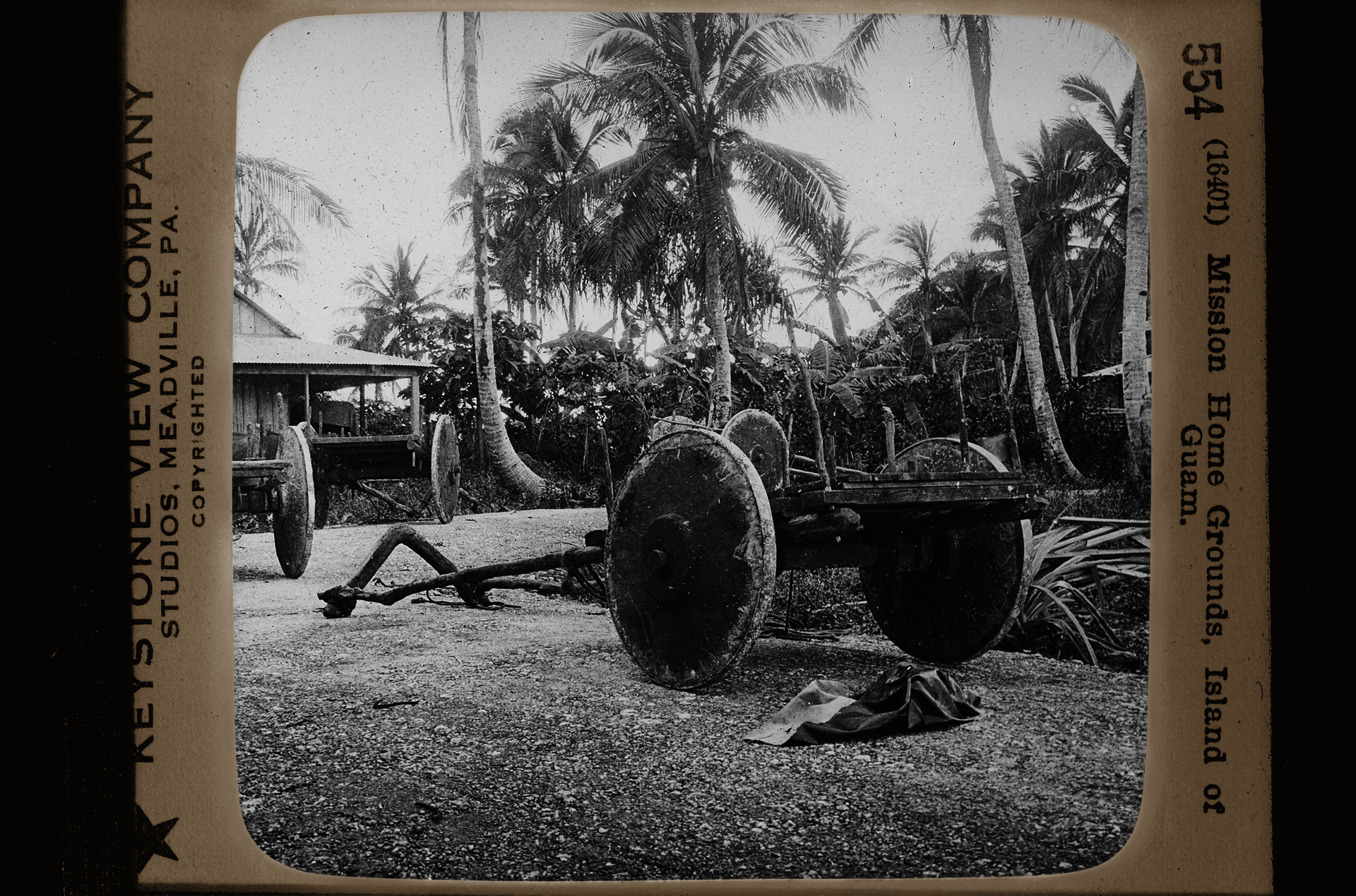INTRODUCTION
Inafa’maolek:
On Being and Believing
in Nature
Craig Santos Perez
Image

Keystone View Company
American, 1892–1920s
Mission Home Grounds, Island of Guam, late 1800s–early 1900s
Gelatin silver on glass
10.2 × 8.3 cm. (4 × 3 ¼ in.)
Gift of Andrew Wallerstein 1994.113.178
“Guela’ yan guelu’, kosiña-yu malofan i tano-mu?” My dad asked as we stood on the dirt road at the threshold of i halom tano, the deep jungle.
In our native language, this translates as “Grandmother and grandfather, may I enter your land?” This is how our people, the Chamorus of the western Pacific Island of Guam, seek petmisu.
“Now you say it,” he told me and pointed. “I taotaomo’na.”
He taught me this protocol because we believe the spirits of our ancestors, i taotaomo’na, dwell throughout the land, amidst the trees, within the roots.
I closed my eyes, asked permission, and listened. No answer. Nothing but the trade winds billowing the canopy. But I still believed.
“Walk carefully,” my dad said. “This is Puntan’s body.”
In our creation story, Puntan and his sister Fu’una sailed through the vast darkness of the sea. Puntan decided to sacrifice his life and drown so that Fu’una can transform his body into an island. Then Fu’una dived into the water, and her body calcified into stone, from which the Chamorus were born.
As we hiked deeper, he taught me the names of the trees we passed: niyok, lemmai, ifit, yoga’, nunu. He explained how the trees were our saina, elders—how they gifted us with food and medicine, clothes and shelter, tools and canoes.
“When you take,” he said, “never take more than you need.”
He picked up a green coconut and cut it open with his machete. He drank, then offered it to me. We stood there in the humid shade, catching our breath, sweating.
“It’s so quiet,” I said.
“No birds,” he replied. “I kulepbla.”
The brown tree snakes arrived on Guam after World War II as stowaways aboard US military ships. Without predators, the snakes quickly spread, almost killing Guam’s entire native bird population. Once echoing with birdsong, the jungles were now silent.
“Will the kulepbla attack us here?” I asked.
“Not now. They’re nocturnal.”
We continued walking for miles until we finally reached our destination: a barbed-wire fence with a rusted No Trespassing sign. I looked through the chain links into the cleared, flat field. In the distance: rows of suburban housing, the commissary, a firing range, soldiers slithering in formation.
My dad gripped the fence, leaned against it, as if he could push it over with his weight.
“That area there,” he pointed, “was my grandfather’s land. America stole it. Eminent domain.”
I was confused why he accused “America” of theft. In school, we always started the morning pledging allegiance and singing “The Star Spangled Banner.” We were taught that Guam became a “territory” of the United States in 1898. We were taught that America brought us freedom and democracy. We were taught that being US citizens was the greatest gift.
“Why did they steal it?”
“When they look at our land, they don’t see how sacred it is. They don’t respect the taotaomo’na. To them, this is just empty space for their bases.”
These fences were ubiquitous on Guam. But it was not until many years later, when I started researching and writing about my homeland, that I learned the full extent and impact of the military. Per acre, Guam is one of the most militarized places on the planet. Today, military bases, installations, and munitions storages occupy one third of our small island’s entire landmass. Our harbor has even been dredged to accommodate nuclear aircraft carriers and submarines. That’s why they call Guam the “tip of the spear” in the Asia-Pacific region.
“It’s time to go back,” my dad declared. “Auntie’s funeral is tonight.”
The military not only stole our sacred land, but they have also caused widespread contamination. A dozen Superfund sites and around eighty contaminated dumpsites exist on Guam, leaching toxins and chemicals into the soil and groundwater. Exposure to this pollution has caused Chamorus to suffer and die from high rates of cancer, including many members of my own family.
As we turned away from the fence, my dad said, “They don’t understand inafa’maolek. But you, son, don’t ever forget it.”
In our culture, inafa’maolek is our most important value. It roughly translates as “to make good for each other.” Inafa’maolek teaches us that all things are connected and related, including people, environments, and all species. Because all things are interwoven, we must always act with guinaiya and respetu, love and respect.
I didn’t say it back then, but I will never forget.
Cite this article as
Chicago Style
MLA Style
Shareable Link
Copy this page's URL to your clipboard.

